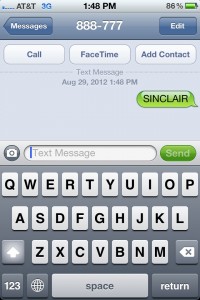
Sinclair Community College’s Emergency Alerts texting service is entering its second year as an advantageous tool that aims to quickly get vital information to Tartans, and it is gaining popularity among campus subscribers.
The Emergency Alerts System, which sends text messages with the support of the Nixle platform, alerts subscribers of extreme weather developments that might affect campus commuters, unscheduled campus closings, and any other campus emergencies.
The service functions as a complementing feature to a communication system that, in the event of a campus emergency, would work to blanket campus visitors with vital, up-to-date information through the Sinclair website, email updates and Facebook.
To sign up for Sinclair Emergency Alerts for all Sinclair locations, text SINCLAIR to 888777. To sign up for alerts for the Dayton campus, text SINCLAIRDAY to 888777
“It’s one of the fastest ways to get an emergency alert because most of our community is running around with a cell phone in their pocket,” said Ed Vander Bush, manager of Marketing Services.
“When we need to send an alert, we send it out in a variety of methods so we can get it to people as quickly as we can. Text messaging has emerged as a really fast way to do that.”
According to Vander Bush, the service’s subscriber rate is growing quite quickly and so far, the feedback from users has been overwhelmingly positive.
With no advertisements or instant messaging spam (spIM), subscribers can expect to only receive emergency-related messages that have been authorized or approved by Sinclair.
“It’s very important that we use the most accessible, possible informational means to get those kinds of messages to people, said Adam Murka, Director of Public Information. “We take it seriously, we don’t abuse it, it’s not frivolous, but it’s done with everybody’s best interest in mind.”
Vander Bush suspects the majority of alerts will be weather-related.
“It’s just another communication channel. Texting has obviously caught on, it’s growing rapidly, and it covers a huge percentage of our population,” said Vander Bush.
The system went online in 2010 with minor adjustments being made during its preliminary run, and in 2011 it officially launched as the service now available to Sinclair students, staff and visitors.
Vander Bush described the service as being a cross-campus venture, combining the efforts of IT staff, Marketing Services, campus police, Sinclair government offices, and many more working with the interest of maintaining the system’s effectiveness.
With a number of other higher educational institutions using Nixle, Vander Bush said he is confident in the service and that Nixle’s platform came highly recommended.
Sinclair was actually able to refer to existing Nixle platform models in the early stages of the service’s development.
“You build it hoping you don’t need it. No matter what kind of emergency it is, you always hope you don’t need it, but you’re probably going to. So you have to build that plan in, and the best way I know to do this stuff is to build as many different means and modes in as you can, so that no matter what the situation is, you’ve delivered your message and there’s a great chance that people in the system, which are students, faculty and staff, are going to see what they needed to see,” said Murka.
For more information about Sinclair Emergency Alerts or to find listings for Courseview, Englewood, Huber Heights or Preble County Learning Center, visit www.sinclair.edu/alerts.
